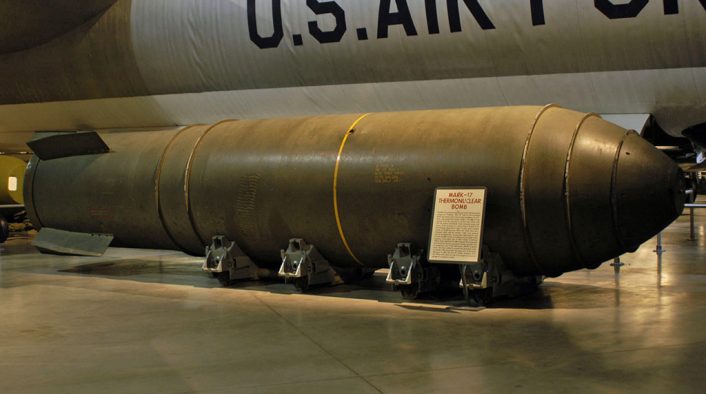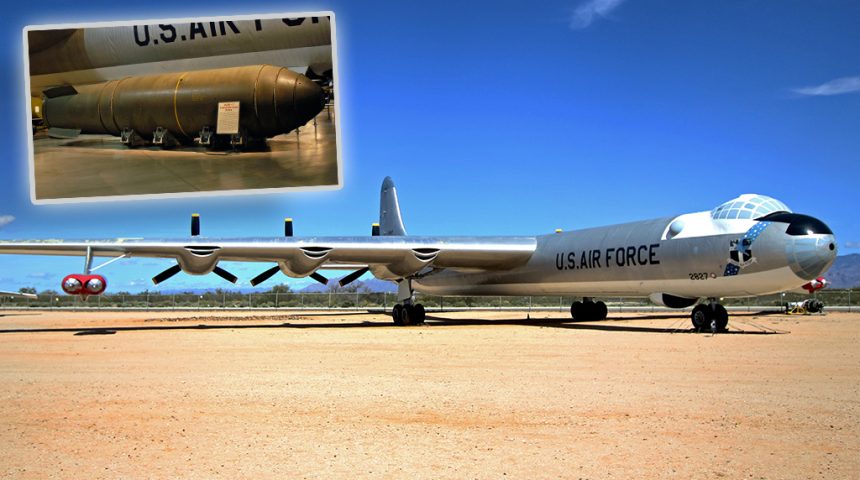The Day a B-36 Accidently Dropped the Largest U.S. Hydrogen Bomb on Kirtland AFB.
In the wake of yesterday’s news that the U.S. has pulled out of the Open Skies Treaty of surveillance flights that verify compliance with nuclear arms limitations treaties, it’s worth revisiting a terrifying incident that occurred 63 years ago today: the formerly-classified Kirtland AFB Accidental B-36 Hydrogen Bomb drop on May 22, 1957.
The Mk 17 hydrogen bomb was an attempt to drastically increase the destructive force of a nuclear weapon. It was horrifically successful. And almost went terrifyingly wrong.
In technical terms, according to Pulitzer Prize finalist and investigative journalist Eric Schlosser in his book, “Command and Control: Nuclear Weapons, The Damascus Accident, and the Illusion of Safety” (pp. 161,), the Mk 17 was the largest operational hydrogen bomb ever deployed by the United States. It’s difficult to make a meaningful comparison of its destructive force compared to the nuclear bomb dropped on Hiroshima, but a reasonable estimate is that the Mk 17 is greater than 1,000 times more powerful than “Little Boy”, the Hiroshima nuclear bomb. Trying to envision the destructive force of a Mk 17 is beyond normal comprehension. Accidentally dropping one is even harder to imagine, but it happened.
1148 Hrs. Local, Wednesday, May 22, 1957; Downwind Traffic Leg, Runway 26, Kirtland AFB.
Maj. Donald F. Heran, aircraft commander of the B-36 J Peacemaker number 52-2816, straightened his control yoke after finishing the wide, graceful turn to the downwind leg of final approach on Runway 26 at Kirtland AFB outside Albuquerque, New Mexico. He descends through 1,750 AGL altitude on the downward slope of his landing. The goliath, majestic bomber, the largest ever made, churns toward end of the runway in what looks like slow motion. Its six wind-milling pusher propellers generate their distinctive, throbbing hum. It’s four outboard jet engines are quiet as the plane gently settles toward the runway threshold.
In the back of the cavernous B-36J, two men attend to the security of a giant Mk 17 hydrogen bomb. One man, an observer, and another, a co-observer. As with most protocols associated with handling nuclear weapons, two persons must be present at all times.
One of the two men has unzipped his flight jacket as the temperature warms inside the bomber with the decrease in altitude. It is a seemingly small event that may be the metaphorical “flap of the butterfly’s wing”, even now magnifying a horrifying breeze that is building rapidly toward potential Armageddon.
One Minute Later: 1149 Hrs. Local, Wednesday, May 22, 1957; Downwind Traffic Leg, Runway 26, Kirtland AFB.
Droning toward the end of the runway, now descending through 1700 ft. in the back of the B-36J, an accidentally exposed control cable attached to the release lever of the Mk 17’s carrying cradle becomes momentarily snagged on the zipper pull of one of the crewmember’s flight jackets as he confirms removal of a manual safety locking pin in preparation for landing. It is a routine procedure about to go wildly out of control.
He crawls forward six inches.
Eleven Seconds Later: 1150 Hrs. Local, Wednesday, May 22, 1957; Downwind Traffic Leg, Runway 26, Kirtland AFB.
There is a loud “bang”. The sound of aluminum and magnesium panels being battered by some enormous force. A sudden rush of wind blast fills the cavernous bomb bay of the B-36J as the aircraft suddenly lurches upward, as if unburdened of some massive load. The clanking of a loose bomb cradle is barely audible above the deafening wind blast. Daylight blasts into the previously dark expanse of the aircraft fuselage. It is momentarily blinding.
The giant bomb bay is suddenly empty, the bomb bay doors cracked apart and flapping in the windblast outside the aircraft. The weapon suspension chain swings back and forth, now released of their 20-ton burden.
The Mk 17 hydrogen bomb, the largest in the U.S. arsenal, is gone. It has accidentally fallen out of the aircraft, tearing the bomb bay doors open, and disappearing into space.
In the way that seemingly insignificant actions can spiral into unimaginable calamity, either the bomb co-observer’s zipper pull accidently became lodged on an 8-inch long section of (also accidentally) exposed manual release cable, or one of the two observers accidentally put their body weight on the control cable. The cable, just that moment armed to release the weapon, let go.
The gigantic 20-ton hydrogen bomb fell out of the airplane.

Thirty Seconds Later: 1151 Hrs. Local, Wednesday, May 22, 1957; Emergency Go-Around, Downwind Traffic Leg, Runway 26, Kirtland AFB.
The reciprocal of calamity is meticulous caution and redundant safety systems. In this case, they are all that stand between humanity and the worst potential catastrophe in human history.
According to Dave Jackson, a spokesman for the U.S Department of Energy in Albuquerque, New Mexico, “A portion of the actual weapon [had been] removed and put in a different location”. Jackson, speaking to the Associated Press when the accident was finally declassified in August, 1986, went on to say, “It was routine procedure at the time”. Had it not been, the accident could have ended differently enough to alter human history.
The bomb still packed a mighty conventional wallop though. When it hit the ground 4.5 miles south of the Kirtland AFB control tower and just three-tenths of a mile outside the Sandia atomic base reservation where the weapon was, ironically, being delivered to be permanently disarmed, it’s 300-lbs of conventional explosives meant to trigger the nuclear detonation blew a hole 12-feet deep and 25-feet in diameter. It tossed bomb fragments a mile away. It also scattered low-level nuclear material all over the blast site.
The accident remained classified until a brief and unspecific mention in 1981 that walked back its significance. It wasn’t until nearly three decades later that the specifics of the accident finally surfaced in the media following a Freedom of Information Act inquiry by a reporter for the Associated Press and the Journal in August, 1986.
Today, the incident is chronicled in the book, “Broken Arrow: The Declassified History of U.S. Nuclear Weapons Accidents” by Michael H. Maggelet and James C. Oskins (Lulu.com, January, 2008) and in several articles that ran after the incident was finally declassified. But for some reason, the story has never gained traction outside of aviation history buffs and a small group of Cold War veterans, but it remains one of the most terrifying reminders of the unchecked nuclear arms race.









